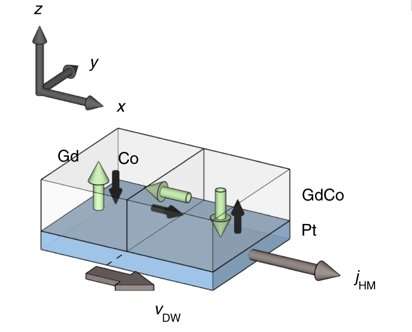September 25, 2018 report
Researchers find ferrimagnets could be used to speed up spintronics devices

Bob Yirka
news contributor

A team of researchers from MIT, the Max-Born-Institut, Technische Universit盲t Berlin and Deutsches Elektronen-Synchrotron (DESY) has found that using ferrimagnets instead of ferromagnets could theoretically speed up spintronics devices. In their paper published in the journal Nature Nanotechnology, the group describes their research and what they found.
Spintronics devices make use of electron spin for a specific purpose. One possible application is in high-density storage devices. Such devices have been proposed using magnetic solitons (a type of quasiparticle) such as nanoscale domain walls in which a material has boundaries between areas where the magnetic moments point down on one side and up on the other, or magnetic skyrmions, which are particles related to baryons. In such a device, the solitons would serve as bits used to encode information鈥攖hey would be moved using something called a racetrack, a device capable of moving domain walls or skyrmions along structures such as nanowires using current pulses that are spin-polarized. But to date, the development of a such a commercial device has been stymied by a problem鈥攖he bits are actually too big, which makes it difficult to move them fast enough to make the whole idea worthwhile. In this new effort, the research team suggests using ferrimagnets instead of using ferromagnets in such devices.
Ferromagnets are traditional magnets, materials that have properties that resemble iron. Ferrimagnets, on the other hand, are materials that have two types of ions with magnetic moments that are not equal, and which are also polarized in opposite directions. The researchers suggest using them could allow for the creation of smaller bits because they allow faster domain wall dynamics to occur鈥攖his is because there would be no change in net angular momentum required to reorient magnetic moments. They claim making the switch would allow for an order of magnitude improvement in both size and speed without resorting to cryogenics. This could result in the creation of new consumer products in a relatively short period of time.
Written for you by our author 鈥攖his article is the result of careful human work. We rely on readers like you to keep independent science journalism alive. If this reporting matters to you, please consider a (especially monthly). You'll get an ad-free account as a thank-you.
More information: Lucas Caretta et al. Fast current-driven domain walls and small skyrmions in a compensated ferrimagnet, Nature Nanotechnology (2018).
Journal information: Nature Nanotechnology
漏 2018 麻豆淫院



















